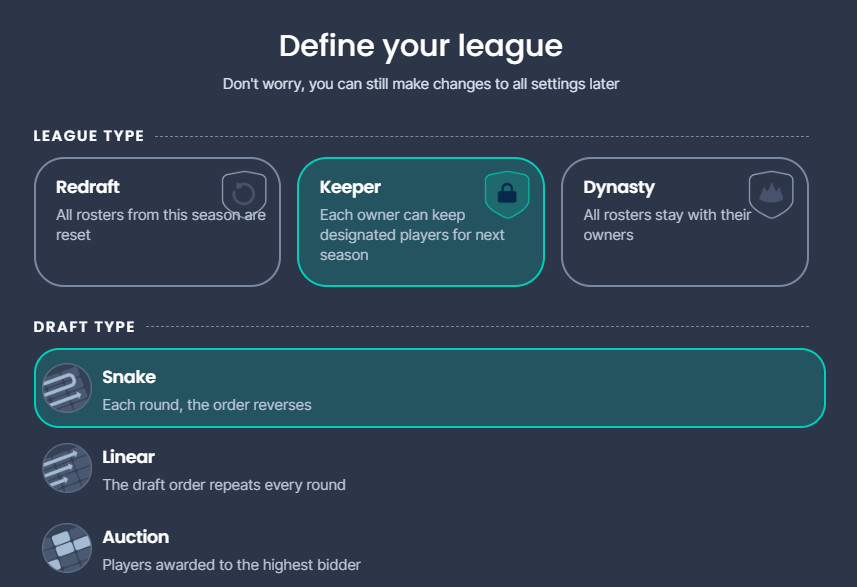Are you curious about what a keeper is in fantasy football? This article provides a detailed explanation of keeper leagues, their rules, strategies, and platforms, helping you dominate your fantasy football season. Discover everything you need to know about keeper leagues at CAUHOI2025.UK.COM, your trusted source for fantasy football insights! We’ll explore keeper strategies, draft picks, and how to maximize your team’s potential.
Keywords: Keeper league, fantasy football, draft strategy, player selection, league rules.
1. Understanding the Keeper Concept in Fantasy Football
A keeper in fantasy football refers to a player on your roster that you retain from one season to the next. Keeper leagues bridge the gap between traditional redraft leagues and dynasty leagues, offering a unique blend of short-term and long-term strategy.
1.1. Redraft vs. Keeper vs. Dynasty Leagues
To fully grasp the concept, let’s compare these three popular formats:
- Redraft Leagues: Each season, you start with a completely new roster, drafting all your players from scratch.
- Keeper Leagues: You can keep a limited number of players from your previous season’s roster. Each year, a new draft is held to fill the remaining roster spots.
- Dynasty Leagues: You retain your entire roster from year to year. New players are acquired through rookie drafts, trades, and free agency.
Keeper leagues provide a balanced approach, allowing for continuity while maintaining the excitement of the annual draft.
1.2. Why Choose a Keeper League?
Keeper leagues offer several advantages:
- Strategic Depth: Deciding which players to keep requires careful evaluation and strategic thinking.
- Year-Round Engagement: Even in the off-season, you’re analyzing player performance and potential keeper options.
- Roster Continuity: Building a team over multiple seasons fosters a sense of investment and loyalty.
According to a survey by the Fantasy Sports Trade Association, keeper leagues are gaining popularity among fantasy football enthusiasts seeking a more immersive experience.
2. Core Rules of Keeper Leagues
While specific rules vary from league to league, some common principles govern keeper leagues:
2.1. Keeper Eligibility
Generally, only players on your active roster at the end of the season are eligible to be kept. If you drop a player mid-season, they typically cannot be retained as a keeper.
2.2. Keeper Duration
Leagues often set limits on how long a player can be kept, typically ranging from one to three years. Some leagues may allow indefinite keeping, but this is less common.
2.3. Keeper Costs
Most leagues implement a “cost” for keeping a player, usually in the form of a forfeited draft pick. This cost is designed to balance the advantage of retaining a valuable player.
2.4. Keeper Deadlines
Teams must declare their keepers before a specific deadline, typically a few weeks before the draft. This allows the league to prepare the draft order and adjust player rankings accordingly.
**2.5. Bypassing Keepers
Players can decline to keep any players. This can be beneficial to gain extra draft picks. However, keep in mind that there must be players worth keeping for the strategy to succeed.
3. Types of Keeper Leagues
Keeper leagues come in several flavors, each with its own nuances:
3.1. No-Cost Keeper League
This is the simplest format, where teams can keep a set number of players without forfeiting any draft picks. While straightforward, this method can be less strategic, as teams are incentivized to keep only the highest-value players.
3.2. Prior Year Draft Spot Keeper League
This popular method ties the cost of keeping a player to the round in which they were originally drafted. For example, keeping a player drafted in the fifth round would cost you your fifth-round pick in the upcoming draft.
3.3. Undrafted Free Agents Keeper League
In this type of league, undrafted players who are picked up off the waiver wire are assigned a token draft position (e.g., 12th round) if they are kept. This adds an extra layer of strategy, as finding hidden gems on the waiver wire can yield valuable keepers.
3.4. ADP (Average Draft Position) Keeper League
This method assigns value to keepers based on their current ADP. If you want to keep a player with a first-round ADP, you’ll need to forfeit your first-round pick. This approach eliminates the advantage of having drafted a player at a lower value in the previous year.
4. Strategies for Keeper Selection
Choosing the right keepers is crucial for long-term success. Here’s a breakdown of key strategies:
4.1. Evaluating Keeper Worth
Assess whether the cost of keeping a player (in terms of draft capital) is justified by their projected performance. Consider their age, injury history, and potential for growth.
4.2. Balancing Value and Opportunity
Look for players who offer a combination of value (low draft cost relative to their potential) and opportunity (high likelihood of increased usage and production).
4.3. Identifying Upside
Prioritize players with the potential to become top performers at their positions. A player with breakout potential can be more valuable than a consistent but less dynamic option.
4.4. Using ADP Data
Utilize ADP data to identify players who are being undervalued. Keeping a player who is projected to outperform their draft position can give you a significant edge.
4.5. Considering Positional Scarcity
Factor in the scarcity of certain positions. Keeping a top-tier running back may be more valuable than keeping a similarly ranked wide receiver, given the depth at the receiver position.
5. Maximizing the Waiver Wire in Keeper Leagues
The waiver wire is a treasure trove of potential keepers. Pay close attention to emerging players and those who may be in line for increased roles due to injuries or depth chart changes.
5.1. Targeting Young Players
Focus on acquiring young players with upside, even if they are not currently producing at a high level. These players may develop into valuable keepers in future seasons.
5.2. Monitoring Depth Charts
Stay informed about team depth charts and potential opportunities for players to rise in the ranks. A backup running back who is one injury away from a starting role can be a valuable addition.
5.3. Analyzing Salary Cap Situations
Examine team salary cap situations to identify potential free agents or players who may be released. These players could become valuable keeper options.
6. Trading Draft Picks in Keeper Leagues
Trading draft picks is a common practice in keeper leagues, especially those that use draft capital as a cost for keeping players. Understanding how to effectively trade picks can be a game-changer.
6.1. Prioritizing High Draft Picks
Generally, it’s better to have high draft picks as they have greater value than low ones. Use lower picks for waiver wire acquisitions to complete your team.
6.2. Trading Based on Player Value
Evaluate the future value of players. Make trades based on whether the player’s value will increase or decrease. You want to acquire players who will continue to appreciate in future seasons.
7. Platforms for Hosting Keeper Leagues
Several popular fantasy football platforms support keeper leagues:
7.1. Sleeper
Sleeper is a modern and user-friendly platform that is well-suited for keeper leagues. It offers robust features for managing keepers, trading draft picks, and customizing league settings.
 Sleeper
Sleeper
Sleeper Fantasy makes it incredibly easy to set up a keeper format when creating your league. The commissioner can set up the value for a sleeper in terms of draft picks forfeited. It also allows for the migration of existing leagues from other sites
7.2. ESPN
ESPN is a widely used platform for fantasy football, and it also supports keeper leagues. While ESPN’s keeper features may not be as extensive as Sleeper’s, it offers a reliable and familiar experience for many users.
ESPN’s league settings allow for between 0-3 sleepers to be kept, per team, but they do allow for managers to set the value of a sleeper to the round they were taken in the previous season.
7.3. Yahoo
Yahoo is another popular platform that supports keeper leagues. It offers a range of customizable settings and tools for managing keepers, making it a solid option for leagues of all sizes.
Yahoo gives league managers the option to set up keeper leagues in the settings and provides a lot of different tools aimed at giving leagues flexibility in their keeper settings. Options like trading draft picks and setting up keepers based on the previous season’s draft position are all available on Yahoo.
8. Joining or Starting a Keeper League
Whether you’re looking to join an existing league or start your own, here are some tips to get you started:
8.1. Joining a Startup League
- Pros: You can influence league settings, play with people you know, and build your team from scratch.
- Cons: Finding committed players can be challenging, and you may need to compromise on rules.
8.2. Taking Over an Existing Team
- Pros: The league is already established, and there may be incentives for new players.
- Cons: You’ll be subject to existing rules, and your keeper options may be limited.
8.3. Setting Up Your Own Keeper League
Before the start of the season, determine the league size. You’ll need at least 8 people, but 10 or 12 are the recommended size for fantasy football. Then find what hosting site you want to use to create your keeper league. Be sure to discuss with your league mates what settings you want to implement.
9. Dynasty vs. Keeper Leagues: Key Differences
While both keeper and dynasty leagues offer a long-term element, there are significant differences:
9.1. Roster Continuity
- Keeper Leagues: Allow you to keep a small number of players, with a new draft each season.
- Dynasty Leagues: Retain your entire roster from year to year, with new players acquired through rookie drafts.
9.2. Management Involvement
- Keeper Leagues: Require less year-round management compared to dynasty leagues.
- Dynasty Leagues: Demand constant attention to player development, trades, and rookie scouting.
9.3. Strategic Focus
- Keeper Leagues: Balance short-term and long-term strategy, with an emphasis on maximizing value in the annual draft.
- Dynasty Leagues: Emphasize long-term team building, with a focus on acquiring young talent and managing the salary cap.
Choosing between a keeper and dynasty league depends on your preferred level of commitment and strategic depth.
10. Answering Your Questions About Keeper Leagues (FAQ)
Here are some frequently asked questions about keeper leagues:
-
What happens if a keeper gets injured before the season?
- Most leagues have rules allowing you to drop an injured keeper and select a replacement.
-
Can I trade my keepers?
- Yes, keepers can be traded in most leagues, but the rules may vary.
-
What if I don’t want to keep any players?
- You are typically allowed to forego keeping any players and enter the draft with all your picks.
-
How do I determine the value of a potential keeper?
- Consider their projected performance, draft cost, and potential for growth.
-
What is the best strategy for keeper selection?
- Focus on maximizing value and opportunity, targeting players with breakout potential.
-
How does the waiver wire work in keeper leagues?
- The waiver wire allows you to acquire free agents, who may become valuable keepers in future seasons.
-
Can I keep a player I picked up off the waiver wire?
- Yes, undrafted players picked up off the waiver wire are typically eligible to be kept.
-
What is the difference between a keeper league and a dynasty league?
- Keeper leagues allow you to keep a small number of players, while dynasty leagues allow you to retain your entire roster.
-
Which platform is best for hosting a keeper league?
- Sleeper is a modern and user-friendly platform that is well-suited for keeper leagues.
-
How do I find a keeper league to join?
- Check online fantasy football communities, ask friends, or start your own league.
Conclusion: Embrace the Challenge of Keeper Leagues
Keeper leagues offer a unique and rewarding fantasy football experience. By understanding the rules, strategies, and platform options, you can build a competitive team and enjoy the year-round excitement of this dynamic format. Visit CAUHOI2025.UK.COM for more insights and tips to dominate your keeper league!
Ready to take your fantasy football game to the next level? Join a keeper league and experience the thrill of building a team over multiple seasons. And for more expert advice and resources, be sure to visit CAUHOI2025.UK.COM!
Do you have more questions about keeper leagues? Are you looking for personalized advice? Contact CAUHOI2025.UK.COM today!
Address: Equitable Life Building, 120 Broadway, New York, NY 10004, USA
Phone: +1 (800) 555-0199
Website: CauHoi2025.UK.COM

